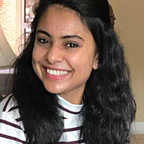Golu
This navratri is quite the unusual navratri celebration for me.
I grew up in a Maharashtrian family. At the beginning of the navratri celebration, my mother would install a ceremonial kalash and a coconut on top of it surrounded by soil with grains in it. Over the period of 9 days, the grains sprouts and a feet high grass grows in the pot. Every morning and evening arti is conducted. This was my most favorite part of navratri. My mom has a collection of artis that are navratri special and are only sung during this time of the year. Our family of 5 would gather for the evening arti, I would be assigned the duty to play the cymbals. My mother would fast for 9 days. On 7th day, a special preparation, Kadakni, which looks very much like papad is made at home. The Kadkanis are tied together to make a garland and it is then tied in the home mandir.
In my pre teen years, navratri was also the time when the north indian aunties in our housing complex would invite me and my friends for Kanya puja at their home and treat us with food and gifts.
As I grew up, navratri was also the time of the year where communal dancing would take place. Garba and Dandiya. In my early teens, this festival always clashed with the mid term exams. So I and my friends would discuss around what time we would gather at the housing complex to take part in the dandiya event.
In later teens, this was replaced by the excitement of going to garba events with college friends. These events somehow had a notorious image in my parents mind, so I never got the permission to attend these events.
As years progressed, I moved overseas. I was independent working woman. Around the navratri a lot of talented artists were called by event organizers to America to host events for the Indian diaspora. On a weekend, typically a Saturday night, our group of friends would dress up in traditional outfits and head to these events for a night of dancing and Indian food. One of these years was very special as I got to perform at one of the events half time show along with my dance group.
Initially I was planning to be in Kolkata for Navratri/ Durga Pujo, especially for the Pujo Kathi Rolls. But when we bought the tickets to a cricket match in Ahmedabad for 4th Nov, I thought being in Gujrat and witnessing the Garba energy would be an experience. However, this year, I found myself in South India for Navratri.
I was in Chennai and on the insistance of my 10 year old sister, I accompanied her to her friends home for Golu. Golu is a ceremonial setup layered in odd number of steps. The host family explained to me the significance of Golu is to demonstrate that everyone in nature dwells in harmony, so they have figurines of reptiles, animals, human beings and divine beings in there.The steps denote evolution. So at the bottom most steps would be reptiles and animals, followed by humans and then divine beings.
The Golu setup that I visited had 7 steps. I got to learn about many stories. A shiva statue surrounded by 4 human devotees. They are called Nalvar. These were the people who composed lot of songs in Shiva’s devotion. A king too is a part of this 4 member squad. Then there were human figures of traders. A set of Subramanyam Swami’s figurines from the different places where he is highly worshipped. Paramnee, a place where he got the clarity that with clear thinking and high conscious mind, one himself is like a fruit. A figurine from the place where he married 2 wives.
The Golu setup also had a set of dashavatara — 10 births of Vishnu. A set that contained statues of 8 Lakshmis — Santanalakshmi, Dhanlakshmi, Dhanyalakshmi, Dhairyalakshmi, Srilakshmi, Gajalakshmi, Vidyalakshmi and Vijaylakshmi.
At the penultimate step were sets that showed Shiva and Parvati at Kailash with devotees and Vishnu and Lakshmi in the sea, they too surrounded by devotees
In the golu setup, I noticed two figures at the ultimate step. The figures had 4 legs and a face of a female. Out of curiousity I asked, the host family explained to me that those figures were Kamadhenu — the holy cow. The cow is considered to be always giving. From the cowdung, people in early times and even today in remote areas, patch their homes. It also acts as fuel. The milk from cow is the source for all dairy items. The urine of cow is also considered as holy. In general, woman is considered as the giver in the societal roles, hence kamadhenu has face of a female.
Towards the end of the 9 day festival, I arrived in Maharashtra and visited the Durga Puja Pandal near my apartment. The pandal has a elaborate and beautiful statue of Goddess Durga. A stage was setup for the community to conduct and participate in cultural programs. A little later participated in the communal dancing happening at a different venue within my housing complex where DJ played the Garba tracks.
Though I couldn’t make it to Kolkata, I found the Pujo Rolls at the Durga Puja Pandal and did my fake garba moves to the Garba playlist and am looking forward to the next days where I will get to participate in the special Navratri arti by my mother.
